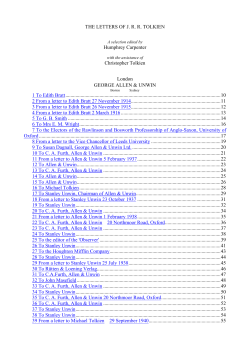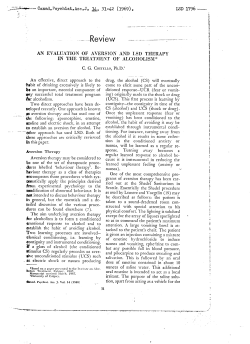
N4013R ISO/IEC JTC1/SC2/WG2 L2/11-096R
ISO/IEC JTC1/SC2/WG2 N4013R L2/11-096R 2011-05-10 Universal Multiple-Octet Coded Character Set International Organization for Standardization Organisation Internationale de Normalisation Международная организация по стандартизации Doc Type: Title: Source: Status: Action: Date: Working Group Document Proposal to encode additional Runic characters in the UCS Michael Everson and Andrew West Individual Contribution For consideration by JTC1/SC2/WG2 and UTC 2011-05-10 0. Introduction. A number of Runic characters should be encoded to fill gaps in the UCS. Three of them are found in the writings of J. R. R. Tolkien, and five of them are found on the Anglo-Saxon Franks Casket. If this proposal is accepted, the following characters will be added to the standard (since the Franks Casket characters replace original inherited runes, those are given on the right for comparison): ᛶ ᛷ ᛸ ᛱ ᛲ ᛳ ᛴ ᛵ 16F1 RUNIC LETTER K 16F2 RUNIC LETTER SH 16F3 RUNIC LETTER OO 16F4 RUNIC LETTER FRANKS CASKET OS 16F5 RUNIC LETTER FRANKS CASKET IS 16F6 RUNIC LETTER FRANKS CASKET EH 16F7 RUNIC LETTER FRANKS CASKET AC 16F8 RUNIC LETTER FRANKS CASKET AESC ᚩ ᛁ ᛖ ᚪ ᚫ 16A9 RUNIC LETTER OS O 16C1 RUNIC LETTER ISAZ IS ISS I 16D6 RUNIC LETTER EHWAZ EH E 16AA RUNIC LETTER AC A 16AB RUNIC LETTER AESC 1. Tolkienian extensions. Although for The Lord of the Rings J. R. R. Tolkien devised and employed two writing systems, the featural Tengwar script and the runiform Cirth script, in The Hobbit and some of his other writings he made use of Old English runes. Owing to the importance of Tolkien as one of the major writers of the twentieth century and in particular to the scholarly attention given to his linguistic work, it is proposed here to add two character to the Runic block in order to enable his texts to be completely represented in the UCS. The adaptation of the Runic alphabet Tolkien used for writing modern English is given here, in Latin alphabetical order (See Figure 2, 3, 4, 5). ᚫ a, ᛒ b, ᚳ c, ᛞ d, ᛖ e, ᚠ f, ᚷ g, ᚻ h, ᛁ i/j, ᛶ k, ᛚ l, ᛗ m, ᚾ n, ᚩ o, ᛈ p, ᚱ r, ᛋ s, ᛏ t, ᚢ u/v, ᚹ w, ᛉ x, ᚣ y, ᛦ z, ᛠ ea, ᛟ ee, ᛇ eo, ᛝ ng, ᛸ oo, ᛷ sh, ᛥ st, ᚦ th The red characters ᛶ k, ᛷ sh, and ᛸ oo are not encoded in the UCS; the blue characters ᚳ c and ᛋ s, and ᛟ ee are similar to k, sh, and oo. A variety of texts written by Tolkien make use of these letters. The titlepage text of The Hobbit reads: 1 ᚦᛖ ᚻᚩᛒᛒᛁᛏ ᚩᚱ ᚦᛖᚱᛖ ᚫᚾᛞ ᛒᚫᚳᛶ ᚫᚷᚫᛁᚾ ᛒᛖᛁᛝ ᚦᛖ ᚱᛖᚳᚩᚱᛞ ᚩᚠ ᚫ ᚣᛠᚱᛋ ᛁᚩᚢᚱᚾᛖᚣ ᛗᚫᛞᛖ ᛒᚣ ᛒᛁᛚᛒᚩ ᛒᚫᚷᚷᛁᚾᛋ ᚩᚠ ᚻᚩᛒᛒᛁᛏᚩᚾ ᚳᚩᛗᛈᛁᛚᛖᛞ ᚠᚱᚩᛗ ᚻᛁᛋ ᛗᛖᛗᚩᛁᚱᛋ ᛒᚣ ᛁ ᚱ ᚱ ᛏᚩᛚᛶᛁᛖᚾ ᚫᚾᛞ ᛈᚢᛒᛚᛁᛋᚻᛖᛞ ᛒᚣ ᚷᛇᚱᚷᛖ ᚫᛚᛚᛖᚾ ᚫᚾᛞ ᚢᚾᚹᛁᚾ ᛚᛏᛞ ÞE HOBBIT OR ÞERE AND BACK AGAIN BEIŊ ÞE RECORD OF A YÆRS IOURNEY MADE BY BILBO BAGGINS OF HOBBITON COMPILED FROM HIS MEMOIRS BY I R R TOLKIEN AND PUBLISHED BY GŒRGE ALLEN AND UNWIN LTD In Thror’s map the following text is given in “moon letters”: ᛋᛏᚫᚾᛞ ᛒᚣ ᚦᛖ ᚷᚱᛖᚣ ᛋᛏᚩᚾᛖ ᚻᚹᛁᛚᛖ ᚦᛖ ᚦᚱᚢᛋᚻ ᛶᚾᚩᚳᛶᛋ ᚫᚾᛞ ᚦᛖ ᛋᛖᛏᛏᛁᚾᚷ ᛋᚢᚾ ᚹᛁᚦ ᚦᛖ ᛚᚫᛋᛏ ᛚᛁᚷᚻᛏ ᚩᚠ ᛞᚢᚱᛁᚾᛋ ᛞᚫᚣ ᚹᛁᛚᛚ ᛋᚻᛁᚾᛖ ᚢᛈᚩᚾ ᚦᛖ ᛶᛖᚣᚻᚩᛚᛖ STAND BY ÞE GREY STONE HWEN ÞE ÞRUSH KNOCKS AND THE SETTING SUN WITH THE LAST LIGHT OF DURINS DAY WILL SHINE UPON THE KEYHOLE As is the following note by Thrór: ᚠᛁᚢᛖ ᚠᛟᛏ ᚻᛁᚷᚻ ᚦᛖ ᛞᚩᚱ ᚫᚾᛞ ᚦᚱᛟ ᛗᚫᚣ ᚹᚫᛚᛶ ᚫᛒᚱᛖᚫᛋᛏ FIUE FŒT HIGH ÞE DOR AND ÞRŒ MAY WALK ABREAST The ᛷ sh and ᛸ oo characters were used in a letter from Tolkien to Mrs Ferrer; see Figure 3. 2. Cryptogrammic Anglo-Saxon runes. The Franks Casket (or Auzon Runic Casket) is a small and beautiful chest made out of whalebone and dating to 8th century England. It presents a number of carved historical scenes alongside of which are extensive texts in Runes. On the right side of the casket, which appears to be an illustration of Sigurðr who slayed the dragon Fáfnir, a set of “cryptogrammic” Runes are used for the vowels. The ordinary rune vowels are used on the other three sides. The text on that side of the casket reads: ᚻᛳᚱ ᚻᛱᛋ ᛋᛲᛏᛵᚦ ᛱᚾ ᚻᛵᚱᛗᛒᛳᚱᚷᛵ her hos sitæþ on hærmbergæ ᛴᚷᛚ... ᛞᚱᛲᚷᛲᚦ ᛋᚹᛵ ᚻᛲᚱᛲ ᛳᚱᛏᛴ ᛳᚷᛲ ᛋᚷᚱᛴᚠ agl… drigiþ; swæ hiri erta egi sgraf ᛋᛵᚱᛞᛖᚾ ᛋᛱᚱᚷᛵ ᛴᚾᛞ ᛋᛳ ᛏᛱᚱᚾᛵ særden sorgæ and se tornæ Here these “cryptogrammic” Runes are shown in red; note that ᛖ is the standard rune for e, rather than cryptogrammic ᛳ e. Note too the ligature of ᚠ f and ᚪ a, where the latter is not the cryptogrammic ᛴ a. These characters are analogous to the cryptogammic letters encoded for Coptic (N2744, N). Although the Franks Casket is a single text, it is one of the most important Anglo Saxon texts, and runologists and Anglo-Saxonists need to be able to represent the text accurately, in plain text, just as Copticists can represent cryptogrammic letters in their texts. It would be wrong to consider the characters proposed here as mere “presentation forms” of the standard Runic characters; they fail the legibility test, for one thing. 2 Unicode Character Properties 16F1;RUNIC 16F2;RUNIC 16F3;RUNIC 16F4;RUNIC 16F5;RUNIC 16F6;RUNIC 16F7;RUNIC 16F8;RUNIC LETTER LETTER LETTER LETTER LETTER LETTER LETTER LETTER K;Lo;0;L;;;;;N;;;;; SH;Lo;0;L;;;;;N;;;;; OO;Lo;0;L;;;;;N;;;;; FRANKS CASKET OS;Lo;0;L;;;;;N;;;;; FRANKS CASKET IS;Lo;0;L;;;;;N;;;;; FRANKS CASKET EH;Lo;0;L;;;;;N;;;;; FRANKS CASKET AC;Lo;0;L;;;;;N;;;;; FRANKS CASKET AESC;Lo;0;L;;;;;N;;;;; Ordering These characters should be inserted into the unified sort order for Runic as follows: ᚠ << ᚡ < ᚢ << ᚤ << ᚥ < ᚦ << ᚧ < ᚨ << ᚩ << ᚬ << ᚭ << ᚮ < ᛱ < ᚯ < ᚰ < ᚱ < ᚲ << ᚳ << ᚴ << ᚵ << ᚶ < ᛶ < ᚷ < ᚹ << ᛩ < ᚺ << ᚻ << ᚼ << ᚽ < ᚾ << ᚿ << ᛀ < ᛁ << ᛂ < ᛲ < ᛃ << ᛄ < ᛅ << ᛆ < ᛇ < ᛈ << ᛕ < ᛉ < ᛊ << ᛋ << ᛪ << ᛌ << ᛍ << ᛎ < ᛷ < ᛏ << ᛐ << ᛑ < ᛒ << ᛓ << ᛔ < ᛖ < ᛳ < ᛗ << ᛘ << ᛙ < ᛚ << ᛛ < ᛜ << ᛝ < ᛞ < ᛟ < ᛸ < ᚪ < ᛴ < ᚫ < ᛵ < ᚣ < ᛠ < ᛣ < ᚸ < ᛤ < ᛡ < ᛢ < ᛥ < ᛦ << ᛧ << ᛨ Figures Figure 1. Thror’s map showing the Tolkienian runic extensions. 3 Figure 2. Sample text showing Runic text on the title page of a recent edition of The Hobbit. Figure 3. Letter from J. R. R. Tolkien to Mrs Ferrer, making use of RUNIC LETTER K (contrasting with RUNIC LETTER CEN) and RUNIC LETTER SH (contrasting with RUNIC LETTER SIGEL LONG-BRANCH-SOL S) and RUNIC LETTER OO (contrasting with RUNIC LETTER OTHALAN ETHEL O). 4 Figure 4. The right panel of the Franks Casket, showing the cryptogrammic runes. 5 Figure 5. Description of the text of the right panel of the Franks Casket from Ralph Warren Victor Elliott’s Runes: An introduction (Manchester University Press, 1959; 2nd edition, 1989), giving a transcription and transliteration of the text. 6 16A0 Runic 16A 0 16A6 16A7 16F0 16B1 16B2 16C1 16D1 16E1 16F1 ᛂ ᛒ ᛢ ᛲ 16C2 16D2 16E2 16F2 16B3 16C3 16D3 16E3 16F3 16B4 16C4 16D4 16E4 16F4 16B5 16C5 16D5 16E5 16F5 16B6 16C6 16D6 16E6 16F6 16B7 16C7 16D7 16E7 16F7 ᚨ ᚸ ᛈ ᛘ ᛨ ᛸ 8 16A8 16B8 16C8 16D8 16E8 16F8 ᚩ ᚹ ᛉ ᛙ ᛩ 16A9 16B9 16C9 16D9 16E9 ᚪ ᚺ ᛊ ᛚ ᛪ 16AA 16BA 16CA 16DA 16EA ᚫ ᚻ ᛋ ᛛ ᛫ B 16AB 16BB 16CB 16DB 16EB ᚬ ᚼ ᛌ ᛜ ᛬ 16AC 16BC ᚭ ᚽ D 16AD 16BD 16CC 16DC 16EC ᛍ ᛝ ᛭ 16CD 16DD 16ED ᚮ ᚾ ᛎ ᛞ ᛮ E 16AE F 16E0 ᚧ ᚷ ᛇ ᛗ ᛧ ᛷ 7 C 16D0 ᚦ ᚶ ᛆ ᛖ ᛦ ᛶ 6 A 16C0 ᚥ ᚵ ᛅ ᛕ ᛥ ᛵ 16A5 9 16F ᚤ ᚴ ᛄ ᛔ ᛤ ᛴ 16A4 5 16E ᚣ ᚳ ᛃ ᛓ ᛣ ᛳ 16A3 4 16B0 ᚢ ᚲ 16A2 3 16D ᚡ ᚱ ᛁ ᛑ ᛡ ᛱ 16A1 2 16C ᚠ ᚰ ᛀ ᛐ ᛠ ᛰ 16A0 1 16B 16FF 16BE 16CE 16DE 16EE ᚯ ᚿ ᛏ ᛟ ᛯ 16AF Printed using UniBook™ (http://www.unicode.org/unibook/) 16BF 16CF 16DF Date: 2011-05-10 16EF 7 16A0 Runic Letters 16A0 16A1 16A2 16A3 16A4 16A5 16A6 ᚠ ᚡ ᚢ ᚣ ᚤ ᚥ ᚦ RUNIC LETTER FEHU FEOH FE F RUNIC LETTER V RUNIC LETTER URUZ UR U RUNIC LETTER YR RUNIC LETTER Y RUNIC LETTER W RUNIC LETTER THURISAZ THURS THORN 16A7 16A8 16A9 16AA 16AB 16AC 16AD 16AE 16AF 16B0 16B1 16B2 16B3 16B4 16B5 16B6 16B7 16B8 16B9 ᚧ ᚨ ᚩ ᚪ ᚫ ᚬ ᚭ ᚮ ᚯ ᚰ ᚱ ᚲ ᚳ ᚴ ᚵ ᚶ ᚷ ᚸ ᚹ RUNIC LETTER ETH RUNIC LETTER ANSUZ A RUNIC LETTER OS O RUNIC LETTER AC A RUNIC LETTER AESC RUNIC LETTER LONG-BRANCH-OSS O RUNIC LETTER SHORT-TWIG-OSS O RUNIC LETTER O RUNIC LETTER OE RUNIC LETTER ON RUNIC LETTER RAIDO RAD REID R RUNIC LETTER KAUNA RUNIC LETTER CEN RUNIC LETTER KAUN K RUNIC LETTER G RUNIC LETTER ENG RUNIC LETTER GEBO GYFU G RUNIC LETTER GAR RUNIC LETTER WUNJO WYNN W 16BA 16BB 16BC 16BD 16BE 16BF 16C0 16C1 16C2 16C3 16C4 16C5 16C6 16C7 16C8 16C9 16CA 16CB 16CC 16CD 16CE 16CF 16D0 16D1 16D2 16D3 16D4 16D5 16D6 16D7 16D8 16D9 16DA 16DB 16DC 16DD 16DE ᚺ ᚻ ᚼ ᚽ ᚾ ᚿ ᛀ ᛁ ᛂ ᛃ ᛄ ᛅ ᛆ ᛇ ᛈ ᛉ ᛊ ᛋ ᛌ ᛍ ᛎ ᛏ ᛐ ᛑ ᛒ ᛓ ᛔ ᛕ ᛖ ᛗ ᛘ ᛙ ᛚ ᛛ ᛜ ᛝ ᛞ 8 → 00FE þ latin small letter thorn → 01BF ƿ latin letter wynn 16DF 16E0 16E1 16E2 16E3 16E4 16E5 16E6 16E7 16E8 16E9 16EA 16F8 ᛟ ᛠ ᛡ ᛢ ᛣ ᛤ ᛥ ᛦ ᛧ ᛨ ᛩ ᛪ RUNIC LETTER OTHALAN ETHEL O RUNIC LETTER EAR RUNIC LETTER IOR RUNIC LETTER CWEORTH RUNIC LETTER CALC RUNIC LETTER CEALC RUNIC LETTER STAN RUNIC LETTER LONG-BRANCH-YR RUNIC LETTER SHORT-TWIG-YR RUNIC LETTER ICELANDIC-YR RUNIC LETTER Q RUNIC LETTER X Punctuation 16EB ᛫ RUNIC SINGLE PUNCTUATION 16EC ᛬ RUNIC MULTIPLE PUNCTUATION 16ED ᛭ RUNIC CROSS PUNCTUATION Golden number runes 16EE ᛮ RUNIC ARLAUG SYMBOL 16EF ᛯ RUNIC TVIMADUR SYMBOL 16F0 ᛰ • golden number 17 • golden number 18 RUNIC BELGTHOR SYMBOL • golden number 19 Tolkienian extensions RUNIC LETTER HAGLAZ H RUNIC LETTER HAEGL H RUNIC LETTER LONG-BRANCH-HAGALL H RUNIC LETTER SHORT-TWIG-HAGALL H RUNIC LETTER NAUDIZ NYD NAUD N RUNIC LETTER SHORT-TWIG-NAUD N RUNIC LETTER DOTTED-N RUNIC LETTER ISAZ IS ISS I RUNIC LETTER E RUNIC LETTER JERAN J RUNIC LETTER GER RUNIC LETTER LONG-BRANCH-AR AE RUNIC LETTER SHORT-TWIG-AR A RUNIC LETTER IWAZ EOH RUNIC LETTER PERTHO PEORTH P RUNIC LETTER ALGIZ EOLHX RUNIC LETTER SOWILO S RUNIC LETTER SIGEL LONG-BRANCH-SOL S RUNIC LETTER SHORT-TWIG-SOL S RUNIC LETTER C RUNIC LETTER Z RUNIC LETTER TIWAZ TIR TYR T RUNIC LETTER SHORT-TWIG-TYR T RUNIC LETTER D RUNIC LETTER BERKANAN BEORC BJARKAN B RUNIC LETTER SHORT-TWIG-BJARKAN B RUNIC LETTER DOTTED-P RUNIC LETTER OPEN-P RUNIC LETTER EHWAZ EH E RUNIC LETTER MANNAZ MAN M RUNIC LETTER LONG-BRANCH-MADR M RUNIC LETTER SHORT-TWIG-MADR M RUNIC LETTER LAUKAZ LAGU LOGR L RUNIC LETTER DOTTED-L RUNIC LETTER INGWAZ RUNIC LETTER ING RUNIC LETTER DAGAZ DAEG D 16F1 16F2 16F3 ᛱ ᛲ ᛳ RUNIC LETTER K RUNIC LETTER SH RUNIC LETTER OO Cryptogrammic letters 16F4 16F5 16F6 16F7 16F8 ᛴ ᛵ ᛶ ᛷ ᛸ Date: 2011-05-10 RUNIC LETTER FRANKS CASKET OS RUNIC LETTER FRANKS CASKET IS RUNIC LETTER FRANKS CASKET EH RUNIC LETTER FRANKS CASKET AC RUNIC LETTER FRANKS CASKET AESC Printed using UniBook™ (http://www.unicode.org/unibook/) A. Administrative 1. Title Proposal to encode additional Runic characters in the UCS. 2. Requester’s name Michael Everson and Andrew West 3. Requester type (Member body/Liaison/Individual contribution) Individual contribution. 4. Submission date 2011-05-10 5. Requester’s reference (if applicable) 6. Choose one of the following: 6a. This is a complete proposal Yes. 6b. More information will be provided later No. B. Technical – General 1. Choose one of the following: 1a. This proposal is for a new script (set of characters) No. Proposed name of script 1b. The proposal is for addition of character(s) to an existing block Yes. 1c. Name of the existing block Runic. 2. Number of characters in proposal 8 3. Proposed category (A-Contemporary; B.1-Specialized (small collection); B.2-Specialized (large collection); C-Major extinct; D-Attested extinct; E-Minor extinct; F-Archaic Hieroglyphic or Ideographic; G-Obscure or questionable usage symbols) Category B.1. 4. Is a repertoire including character names provided? Yes. 4a. If YES, are the names in accordance with the "character naming guidelines" Yes. 4b. Are the character shapes attached in a legible form suitable for review? Yes. 5. Fonts related: 5a. Who will provide the appropriate computerized font to the Project Editor of 10646 for publishing the standard? Michael Everson. 5b. Identify the party granting a license for use of the font by the editors (include address, e-mail, ftp-site, etc.): Michael Everson, Fontographer. 6. References: 6a. Are references (to other character sets, dictionaries, descriptive texts etc.) provided? No. 6b. Are published examples of use (such as samples from newspapers, magazines, or other sources) of proposed characters attached? Yes. 7. Special encoding issue: Does the proposal address other aspects of character data processing (if applicable) such as input, presentation, sorting, searching, indexing, transliteration etc. (if yes please enclose information)? Yes. Unicode character properties above. 8. Additional Information: Submitters are invited to provide any additional information about Properties of the proposed Character(s) or Script that will assist in correct understanding of and correct linguistic processing of the proposed character(s) or script. See above. C. Technical - Justification 1. Has this proposal for addition of character(s) been submitted before? If YES explain No. 2. Has contact been made to members of the user community (for example: National Body, user groups of the script or characters, other experts, etc.)? Yes. The proposers are users of the Runic script. 2a. If YES, available relevant documents 3. Information on the user community for the proposed characters (for example: size, demographics, information technology use, or publishing use) is included? Runologists, Anglo-Saxonists, Tolkienists. 4a. The context of use for the proposed characters (type of use; common or rare) Relatively rare. 4b. Reference 9 5a. Are the proposed characters in current use by the user community? Yes. 5b. If YES, where? In texts dealing with the Franks Casket and the linguistic works of J. R. R. Tolkien. 6. After giving due considerations to the principles in the P&P document must the proposed characters be entirely in the BMP? Yes. 6a. If YES, is a rationale provided? Yes. 6b. If YES, reference Contemporary use and accordance with the Roadmap. 7. Should the proposed characters be kept together in a contiguous range (rather than being scattered)? Yes. 8a. Can any of the proposed characters be considered a presentation form of an existing character or character sequence? No. 8b. If YES, is a rationale for its inclusion provided? 8c. If YES, reference 9a. Can any of the proposed characters be encoded using a composed character sequence of either existing characters or other proposed characters? No. 9b. If YES, is a rationale for its inclusion provided? 9c. If YES, reference 10a. Can any of the proposed character(s) be considered to be similar (in appearance or function) to an existing character? No. 10b. If YES, is a rationale for its inclusion provided? 10c. If YES, reference 11a. Does the proposal include use of combining characters and/or use of composite sequences? Yes. 11b. If YES, is a rationale for such use provided? No. 11c. If YES, reference 11d. Is a list of composite sequences and their corresponding glyph images (graphic symbols) provided? No. 11e. If YES, reference 12a. Does the proposal contain characters with any special properties such as control function or similar semantics? No. 12b. If YES, describe in detail (include attachment if necessary) 13a. Does the proposal contain any Ideographic compatibility character(s)? No. 13b. If YES, is the equivalent corresponding unified ideographic character(s) identified? 10
© Copyright 2025











